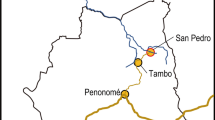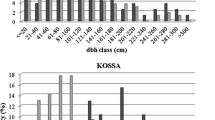Abstract
The traditional shifting cultivation system in the lowlands of Papua New Guinea consists of mixed food crop gardens in which yams (Dioscorea spp.), bananas, taro (Colocasia esculenta) and sugarcane predominate. The cropping cycle is usually for 18 months, followed by a fallow cycle of up to 30 years. During the cropping cycle, two species of fruit trees, Pometia pinnata and Artocarpus altilis are also planted, the leaves of the former also being used as a mulch and green manure in yam cultivation. Fallow succession follows rather systematic patterns about which farmers have a thorough understanding. Robusta coffee, a cash-crop component, has been added to the system in some areas since the late 1950s. It is usually grown in permanent blocks, but is interplanted with Leucaena as shade. Food crops are planted in the establishment stage, bananas and Xantohosoma being retained even in mature coffee gardens. The system seems to be a potentially promising one. But very little quantitative information is available on the production and performance of the system and practically no systematic research has been undertaken. Since the Papua New Guinea fallow gardeners are willing to accept innovations, it will be appropriate and timely to undertake serious studies so that the system can be improved. A few items that merit immediate research attention are indicated.
Similar content being viewed by others
References
Bleeker P (1983) Soils of Papua New Guinea. CSIRO and the Australian National University (ANU) Press, Canberra
Bourke RM (1985) Food, coffee and casuarina: an agroforestry system from the Papua New Guinea highlands. Agroforestry System Description No. 6, Agroforestry Systems 2:273–279
Clarke WC (1971) Place and People: an Ecology of a New Guinea Community. University of California and ANU Press, Berkeley
Clarke WC (1976) The maintenance of agriculture and human habitats within the tropical forest system. Human Ecology 4:247–259
Clarke WC (1977) The structure of permanence. In: TP Bayliss-Smith and RG Feacham (eds), Subsistence and Survival: Rural Ecology in the Pacific, 363–384, Academic Press, San Francisco
CSIRO (1972) Lands of the Aitape-Ambunti Area. Land Research Series No. 30, Canberra
Grandstaff T (1978) The development of swidden agriculture (shifting cultivation). Development and Change 9 (4): 547–579
Heyligers PC (1968) Quantification of vegetation structure on vertical air photographs. In: CA Stewart (ed), Land Evaluation, 251–262, Macmillan, London
Manner HI (1977) Biomass: its determination and implications in tropical agro-ecosystems: an example from montane New Guinea. In TP Bayliss-Smith and RG Feachem (eds), Subsistence and Survival: Rural Ecology in the Pacific, 215–242, Academic Press, San Francisco
McAlpine JR and Keig G (1982) Supporting traditional farming systems in Papua New Guinea. Research Report 1981–82, CSIRO Division of Land Use Research, 8–11
Paijmans K (ed) (1976) New Guinea Vegetation. CSIRO and ANU Press, Canberra
Author information
Authors and Affiliations
Rights and permissions
About this article
Cite this article
Allen, B.J. Dynamics of fallow successions and introduction of robusta coffee in shifting cultivation areas in the lowlands of Papua New Guinea. Agroforest Syst 3, 227–238 (1985). https://doi.org/10.1007/BF00046956
Issue Date:
DOI: https://doi.org/10.1007/BF00046956




